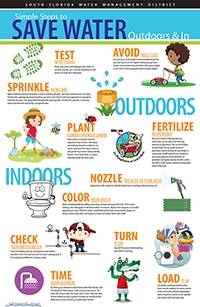By Susanne von Rosenberg, UC Master Gardener of Napa County
When I first moved to Napa 14 years ago, autumn rains arrived fairly reliably around the middle of October. As we are all painfully aware now, autumn rains have been starting later and later…and sometimes not at all.
There is no rain in the near-term forecast, and the National Oceanographic and Atmospheric Administration (NOAA) Climate Predictions Center foresees a 33 percent chance of below-normal rainfall through November coupled with a 60 percent chance of above-normal temperatures. The longer-term prediction for our area is for slightly below-normal rainfall.
The change in rainfall pattern we've been experiencing, with rains coming later than they used to, is consistent with what climate-change models predict. While we can expect roughly the same amount of rain, we will wait longer for it and it will come in fewer, more intense events.
So we need to get used to longer dry seasons. On the other hand, we need to be prepared for heavy rains. How should we adjust our gardening practices to address this change?
Let's talk about an extended dry season first. It's definitely a good idea to continue all the water- conservation practices that we instituted during the last drought. Choose drought-tolerant plants, including natives that are adapted to summer-dry climates. Install proper irrigation systems, such as drip irrigation, to water only those plants that truly need it and in the amount they truly need.
Adjust your watering according to the season. With cooler, shorter autumn days, plants require less water, even if it isn't raining. Mulch your plants to keep the soil cool and reduce evaporation.
We also need to reconsider our fall watering habits. It used to be possible to stop watering trees by late August and many other plants by mid-September. With the change in climate, you now need to continue to water until the rains finally arrive. Also consider our fall heat and low-humidity periods. Look for signs that your plants need water. Drooping leaves and/or dull leaves are two primary indicators. Get to know how your plants show they are thirsty.
How much and how often should you water with this new climate? For annual plants, simply test the soil with your finger. If the soil feels moist one to two inches down, you do not need to water yet. Keep checking and you'll soon have a sense how much water your plants need in this cooler season and how quickly they dry out when we get Diablo winds.
For trees, you can either dig down six inches to see if the soil is dry (this is the best way to check), or simply extend the time between watering. If you were watering your trees once a month in the summer, you might wait five to six weeks for the next round, and then six to seven weeks (mid- to late November) for the next round. Still no rain by New Year's? It might be time to water again! Even our native and other drought-tolerant plants may need supplemental water when rains are delayed.
More frequent heavy rains are another outcome of climate change. We will need to be able manage more rainfall on our properties. Heavy rain can damage soil structure, wash away topsoil and produce standing water in low or poor-drainage areas. You can protect your soil structure by mulching. (Yet another benefit of mulching.) Observe how water flows on your property during a heavy rain. Your goal is to slow down the flow, which you can do by spreading it out, and also by including areas where you intentionally allow the water to pool and infiltrate. Overall, the better your soil, the more rainfall it can absorb and the more water it can hold. Organic mulches do wonders to improve your soil – so, yes, keep mulching.
After a heavy rain, you may see water pooling in areas where you don't want it. In that case, you need to improve the drainage in that area. The best approach is to divert water from that area and to create additional opportunities for water to drain away. You can raise the soil level, dig small swales or create shallow berms. Small changes can make a big difference. You may also find, as I have, that as you improve the soil, your standing-water problem will diminish and eventually disappear.
Gardeners are a resilient and persistent bunch. With preparation, we can manage some of these climate-change challenges.
The UC Master Gardeners of Napa County are volunteers who provide UC research-based information on home gardening and answer your questions. To find out more about upcoming programs or to ask a garden question, visit the Master Gardener website (http://napamg.ucanr.edu) or call (707) 253-4221 between 9 a.m. and noon on Mondays, Wednesdays or Fridays.
Attached Images:


